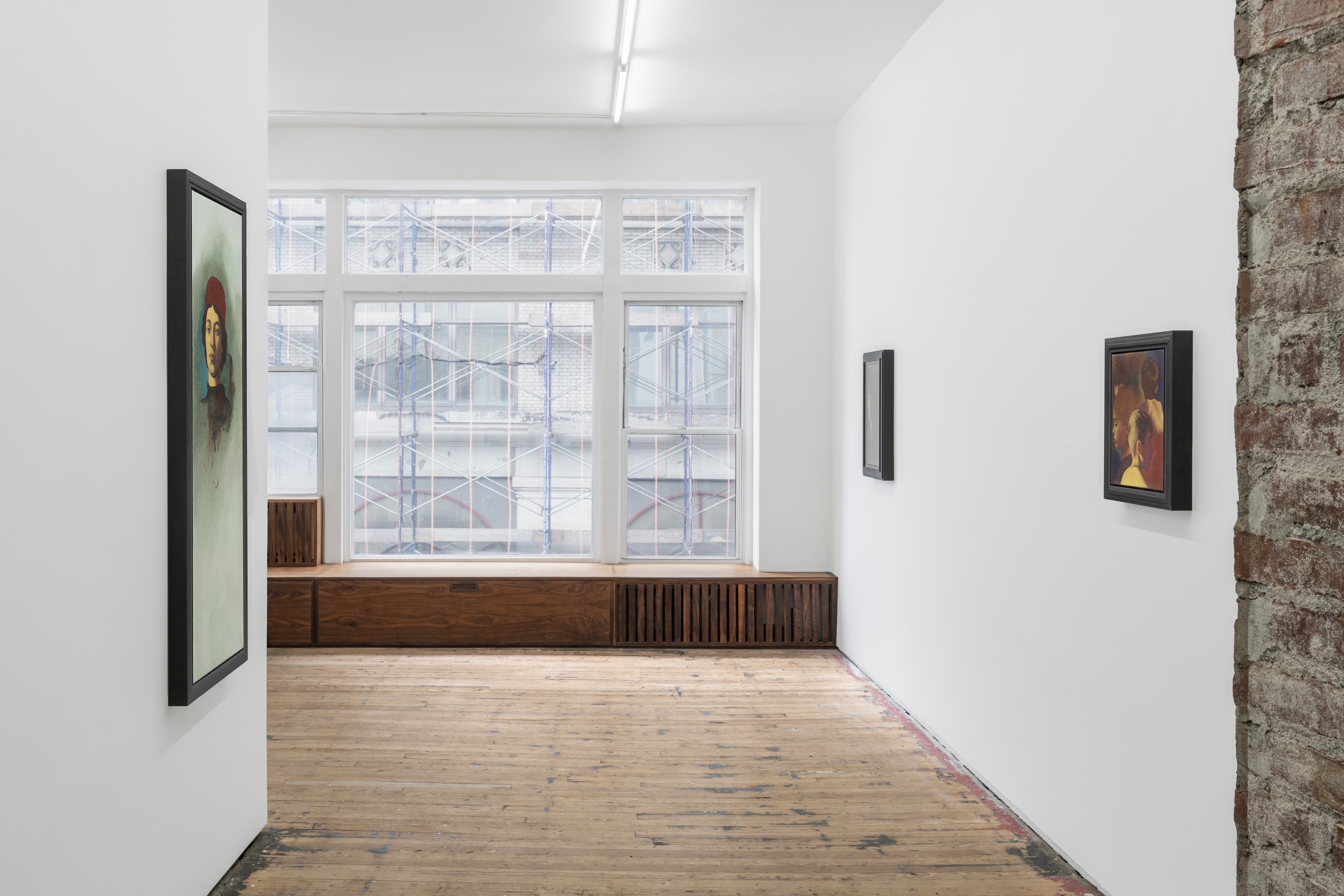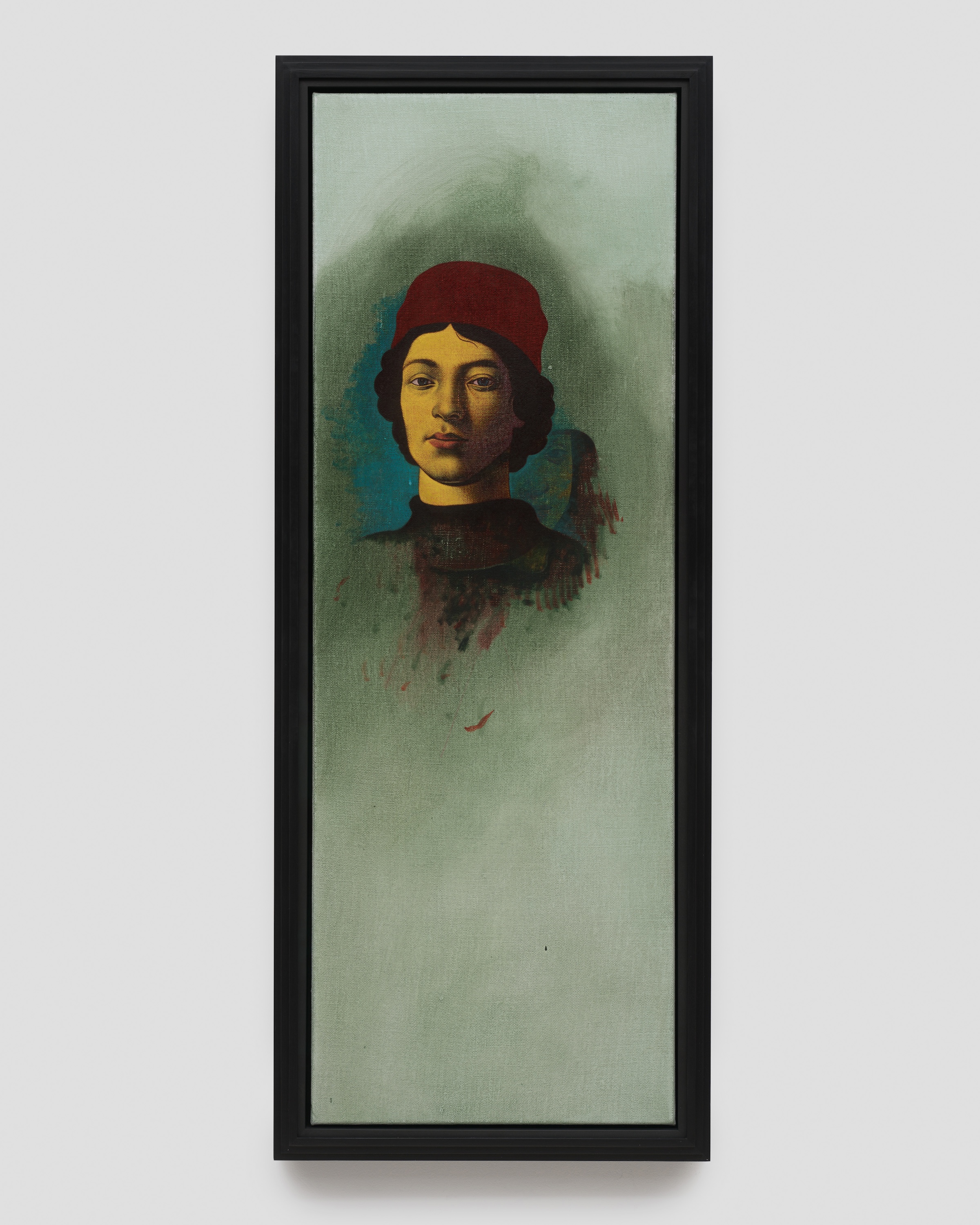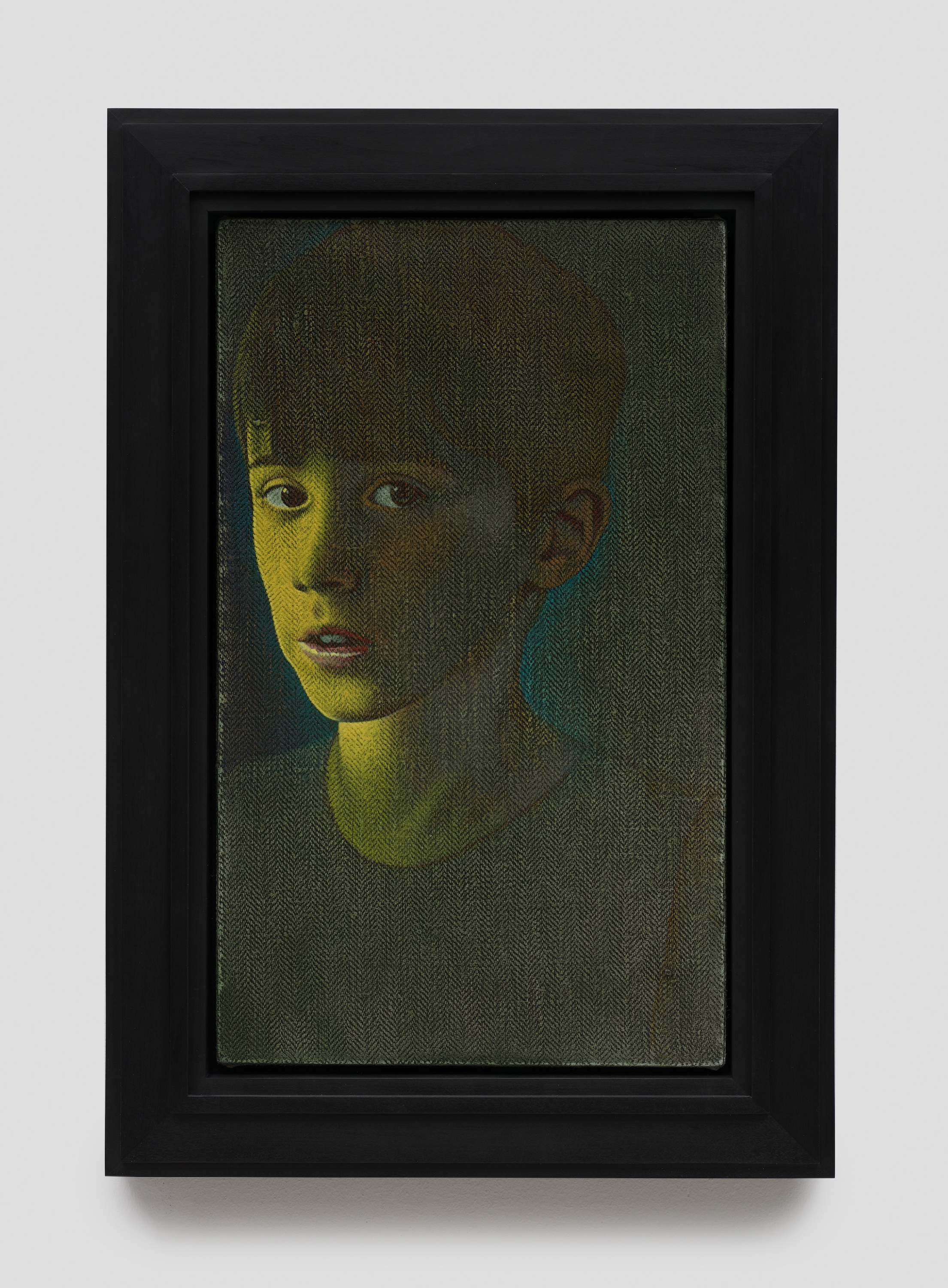Oliver Osborne
Comic Sans
May 6th - June 14th, 2025
What are days for?
Days are where we live.
They come, they wake us
Time and time over.
They are to be happy in:
Where can we live but days?
Ah, solving that question
Brings the priest and the doctor
In their long coats
Running over the fields.
—“Days” by Philip Larkin
Around 1485, the painter Filippino Lippi produced a portrait of an unnamed young man. Angled to the left, the Renaissance subject has pale but luminous skin, curly brown hair; he wears a crimson cap and a blue padded jacket. Lippi had recently completed Masaccio’s frescoes in the Brancacci Chapel in Florence—it is from the evidence of that earlier work that Lippi was credited with this painting (his tutor Botticelli was initially understood to have been the originator).
540 years later, Oliver Osborne presents Portrait of a Youth (After Filippino Lippi) III in his first solo show with Francis Irv in New York. Using Lippi’s subject, he is set against a clear blue sky framed by the edges of a stone window, opening out to an untold vista. The background in Osborne’s tribute painting to Lippi is more visually complicated; the work is an altogether taller expanse of pale gradations and cerulean washes. Instead of a window frame, an amorphous portal of submarine blue introduces another spatial dimension behind the subject’s head. The portrait is further made interesting by an under-imposed image of a younger boy’s face, his eyes gazing out from above the sitter’s left shoulder. His diaphanous apparition is ghostly, its effect akin to time-lapse. (It is the prevailing sense of contingency in this painting that makes it possible to think, then, of Gerhard Richter’s Betty.)
The essential and dynamic quality of Osborne’s work resides in his teasing-out of dogmas about artistic influence. It has been quipped that he is a “new Old Master.” The painter is evidently schooled—steeped, even—in art historical tropes and techniques. But Osborne gives himself permission to mess with the canon and ideas around convention and aesthetic purity. He works with distinct freedom from the baggage that accompanies the anxiety of influence—it’s a compelling lack thereof.
One conceptual work included in the show, titled Comic Sans, beams with lemon-yellow optimism and poses an immediate riddle about position and the occupation of space. This is the kind of gesture by Osborne that gives us license to see a kind of Kippenbergergian irreverence in his oeuvre. Those title words rendered in letters shaped decidedly unlike what the viewer might assume, given the subject’s recognizable ubiquity. Maligned and beloved, most typeface designers simply refer to Comic Sans simply as a “comic type.” (Its creator, Vincent Connare, is reported to have referred to it as “the best joke I’ve ever told.”)
Osborne uses Lead-Tin Yellow paint, which is often dubbed the “Yellow of the Old Masters”. The inherent richness of this pigment lifts the light within the flesh of children—the artist’s own sons—in the four untitled portraits in the exhibition. These are unsentimental and extraordinary, with strange, intimate gazes and postures. From Untitled (May) to the later iteration of the same portrait, the boy subject’s apprehension grows eerily more knowing, while asserting his childlike vantage point. Stripped of nostalgia, this series nonetheless brings to mind Richard Linklater’s film Boyhood, in all its reconstructive passion and longitudinal tracking. Osborne loops back, again and again, and there is no room for accidental repetitions.
Osborne’s sincerity as a painter is established by the intricacy of his brushwork; the sleights of perspective; his devotion to the daily work of a studio artist. Nowhere is this as discernible as in The Sleeping Guard, in which the shadow and contours on herringbone canvas throw into rich relief the model’s gentle postural collapse, the curve of his delicate philtrum and the index finger pointing down. This painting borrows the idea of dutiful repose that one can see in Piero della Francesca’s detail in The Resurrection, but the hybridized inversion of both character (a child versus a man) and the placement of hands signals what Osborne is so adept at provoking: all artists descend from a long line of predecessors, but it is the time over again—for this artist, that certainty of repeated days and Philip Larkin’s “time and time over”—that brings this work so firmly into the contemporary.
— Emmie Francis
Oliver Osborne (b. 1985, Edinburgh) lives and works in Berlin. Selected solo exhibtions have been held at Fondazione ICA Milano (forthcoming); Union Pacific, London (2025, 2022); Tanya Leighton Gallery, Berlin & Los Angeles (2024, 2023); Marc Jancou, Saanen (2024); Galeria Pelaires, Palma de Mallorca (2023); JVDW, Düsseldorf (2022); Braunsfelder, Cologne (2020); Giò Marconi, Milan (2019) and Bonner Kunstverein, Bonn (2018). Selected group exhibitions have been held at Seishodo THE ROOM, Kyoto (2024); Paulina Caspari Gallery, Munich (2024); C L E A R I N G, New York (2024); Francis Irv, New York (2024); Hamburger Kunsthalle, Hamburg, Germany (2020); Peles Empire, Berlin, Germany (2019); Galerie Max Hetzler (2017); Inverleith House, Edinburgh (2017); Museo di Capodimonte, Naples and Sprovieri, Italy (2014).







Oliver Osborne
Untitled (May)
2024-25
Oil on herringbone linen
9⅞ x 7⅞ x 1⅛ in.
25.00 x 20.00 x 3.00 cm
15 x 13 x 2⅜ in. (framed)
38.00 x 33.00 x 6.00 cm (framed)
Untitled (May)
2024-25
Oil on herringbone linen
9⅞ x 7⅞ x 1⅛ in.
25.00 x 20.00 x 3.00 cm
15 x 13 x 2⅜ in. (framed)
38.00 x 33.00 x 6.00 cm (framed)


Oliver Osborne
Comic Sans
2025
Oil on herringbone linen
50½ x 43½ x 1⅛ in.
128.30 x 110.50 x 3.00 cm
51¼ x 44¼ x 2 in. (framed)
130.30 x 112.50 x 5.00 cm (framed)
Comic Sans
2025
Oil on herringbone linen
50½ x 43½ x 1⅛ in.
128.30 x 110.50 x 3.00 cm
51¼ x 44¼ x 2 in. (framed)
130.30 x 112.50 x 5.00 cm (framed)


Oliver Osborne
Multi-Figure Composition
2024-25
Oil on herringbone linen
13¾ x 11¾ x 1⅛ in.
35.00 x 30.00 x 3.00 cm
18⅞ x 16⅞ x 2⅜ in. (framed)
48.00 x 43.00 x 6.00 cm (framed)
Multi-Figure Composition
2024-25
Oil on herringbone linen
13¾ x 11¾ x 1⅛ in.
35.00 x 30.00 x 3.00 cm
18⅞ x 16⅞ x 2⅜ in. (framed)
48.00 x 43.00 x 6.00 cm (framed)


Oliver Osborne
Portrait of a Youth (after Filippino Lippi) III
2025
Oil on linen
50½ x 17⅞ x 1⅛ in.
128.30 x 45.30 x 3.00 cm
54 x 21⅜ x 2⅜ in. (framed)
137.30 x 54.30 x 6.00 cm (framed)
Portrait of a Youth (after Filippino Lippi) III
2025
Oil on linen
50½ x 17⅞ x 1⅛ in.
128.30 x 45.30 x 3.00 cm
54 x 21⅜ x 2⅜ in. (framed)
137.30 x 54.30 x 6.00 cm (framed)


Oliver Osborne
Untitled
2025
Oil on herringbone linen
19¾ x 11¾ x 1⅛ in.
50.00 x 30.00 x 3.00 cm
24¾ x 16⅞ x 2⅜ in. (framed)
63.00 x 43.00 x 6.00 cm (framed)
Untitled
2025
Oil on herringbone linen
19¾ x 11¾ x 1⅛ in.
50.00 x 30.00 x 3.00 cm
24¾ x 16⅞ x 2⅜ in. (framed)
63.00 x 43.00 x 6.00 cm (framed)


Oliver Osborne
The Sleeping Guard
2025
Oil on herringbone linen
29¾ x 17⅞ x 1⅛ in.
75.50 x 45.50 x 3.00 cm
34⅞ x 23 x 2⅜ in. (framed)
88.50 x 58.50 x 6.00 cm (framed)
The Sleeping Guard
2025
Oil on herringbone linen
29¾ x 17⅞ x 1⅛ in.
75.50 x 45.50 x 3.00 cm
34⅞ x 23 x 2⅜ in. (framed)
88.50 x 58.50 x 6.00 cm (framed)
